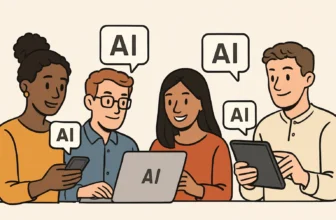
How AI is Unveiling the Future of Diagnostics
What if I told you that AI can now detect certain cancers more accurately than human pathologists… and in a fraction of the time? Mind-blowing, right? But it’s not some sci-fi future—it’s already happening. AI in pathology is changing the game, and honestly, it’s hard not to get excited about it.
If you’re a medical professional, you probably know the pressure that comes with diagnostics. One tiny oversight on a slide could mean a missed diagnosis—or worse, a misdiagnosis. That’s a heavy burden. And if you’re a patient (or love someone who is), the waiting game for results can be agonizing. We all crave faster answers. More certainty. Less “what ifs.”
This is where AI-powered healthcare technology steps in like a superhero with a stethoscope. We’re talking about algorithms that can analyze thousands of pathology slides in minutes. Instead of spending hours peering through a microscope, pathologists can now use AI as a second brain—catching overlooked abnormalities, highlighting high-risk areas, and reducing human error.
So how exactly is AI in pathology helping?
- Speedy analysis: AI can screen large batches of samples way quicker than manual methods. Think diagnostics done in minutes, not days.
- Pinpoint accuracy: Some AI tools have shown comparable or better accuracy than top experts in identifying conditions like breast cancer or prostate cancer. Incredible, right?
- Helping under-resourced areas: In regions with too few specialists, AI models provide support where it’s desperately needed—bringing quality care to more people.
I’ve personally talked to a pathologist friend who now uses an AI platform daily. She told me it’s not about AI replacing her, but enhancing her work. It helps flag suspicious cells faster and gives her more confidence in her diagnoses. “It feels like I have a lab partner who never misses a detail,” she said with a relieved smile.
And here’s a stat that really blew me away: In one study, AI improved lung cancer diagnostics accuracy by nearly 15%. That’s not just a small bump. That’s lives being saved because results are faster and more precise.
So what can you do with all this?
- If you’re a clinician, start exploring AI-enhanced tools your hospital or lab may already have access to. Many are shockingly user-friendly.
- If you’re a patient or caregiver, don’t be afraid to ask your provider if AI is part of their diagnostic process. It’s your health—you deserve the best tools on your side.
- Stay curious. Follow updates in healthcare technology. It’s evolving fast, and those who stay informed will be the ones shaping the future.
We’re entering a world where diseases get caught earlier, second opinions come from machines trained on millions of data points, and diagnoses are made with unprecedented accuracy. AI in pathology is not here to replace the human touch—it’s here to amplify it.
The future of diagnostics? It’s already here. And it’s only getting better.
The Challenges of Traditional Pathology
Did you know that around 15% of medical diagnoses are estimated to be inaccurate? Yep, even with all the training, microscopes, and experience, errors still happen. And when we’re talking about pathology—the backbone of medical diagnostics—that stat hits differently. These aren’t just numbers. They’re missed cancer cells, delayed treatments, and anxious “what-ifs” for patients and doctors alike.
If you’ve ever sat in that limbo waiting for a biopsy result, you know it’s not just the clock ticking—it’s your entire life on pause. On the other side of the microscope, pathologists often work under huge pressure. They’re trying to review hundreds of slides, interpret complex patterns, and spot needle-in-a-haystack abnormalities. All while racing the clock. Sound like a recipe for burnout and errors? That’s because it sometimes is.
So, what’s actually going wrong?
Let’s break it down:
- Subjectivity: Traditional pathology relies heavily on human interpretation. Two pathologists might analyze the same slide and come to different conclusions. Not 100% reassuring, right?
- Time-Consuming: Processing samples, preparing slides, reviewing them under a microscope—this all takes time. Days, sometimes even weeks. And in critical cases, that delay could change everything.
- Volume Overload: Many pathology departments are understaffed, and patient load is increasing. One overworked pathologist may be reviewing thousands of slides a week. Mistakes are not just possible—they’re inevitable.
I’ll never forget a friend of mine who went through a whirlwind of conflicting reports for a suspected thyroid cancer. First, her biopsy seemed benign. Then, a second opinion flagged something suspicious. Weeks of anxiety later, final confirmation showed it was malignant. Luckily, it was early. But that delay? It almost changed everything. This isn’t rare—it’s happening more than we realize.
How are we fixing this?
Healthcare systems aren’t just sitting quietly with clipboards. They’re shaking things up with new strategies:
- Digital Pathology: More labs are shifting from glass slides to digital ones—way easier to analyze, store, and share. Remote consultations? Much faster.
- Second-opinion Networks: Hospitals are creating more streamlined ways to get fresh eyes on tricky cases. Think collaborative diagnosis with checks and balances built-in.
- AI Technology: Advanced algorithms are now acting like a digital assistant for pathologists—flagging abnormalities, highlighting suspicious areas, and reducing oversights.
This isn’t about replacing doctors with robots—it’s about giving professionals the tools to do what they do *better*. Think of AI as the second set of eyes, trained on millions of data points, that never gets tired or distracted. And guess what? Studies are already showing AI’s accuracy can rival—and in some cases, surpass—experienced pathologists when used as an aid.
Better Days Are Coming
We’re turning a corner, slowly but surely, on one of healthcare’s most delicate problems. While traditional pathology has served us for decades, it’s clear it’s time to evolve. And that evolution is happening—right now, in labs and hospitals around the world.
So whether you’re a clinician tired of defensive medicine or a patient craving clarity and speed—hope’s on the horizon. And the best part? With smarter tools joining forces with brilliant humans, the future looks both faster *and* more accurate. Let’s move diagnostics from frustrating question marks to confident periods. 💪
AI’s Role in Enhancing Diagnostic Accuracy
Did you know that pathologists review around 20,000 slides a year and still face a diagnostic error rate of up to 15%? Yep, even the best-trained eyes in the business can miss things — not because of lack of skill, but because let’s face it, they’re human. That’s where AI steps in, not to replace expertise, but to seriously boost it.
We’ve all been there — stressed out by a delayed test result or frustrated by medical uncertainty. Whether you’re a pathologist hunched over the microscope for hours or a patient anxiously waiting for news, the diagnostic process can feel like a marathon with no finish line in sight. It’s slow, it’s complex, and let’s be honest — it’s not immune to error.
So, how is AI helping solve this?
AI-driven technologies in pathology are, quite literally, changing the game. Think software that can scan hundreds of high-res slides in mere minutes. We’re talking about deep learning algorithms trained on thousands (sometimes millions!) of images to recognize patterns the human eye could easily overlook — especially in those sneaky, rare conditions that only show up once in a blue moon.
I chatted with a friend, Dr. Leena, a practicing pathologist, who started using AI-assisted diagnostic tools in her hospital’s lab. She told me about a case where the AI flagged an extremely rare subtype of lymphoma during a routine sample analysis. Something even her skilled team might have dismissed as an anomaly. That input allowed them to zero in, double-check, and confirm a diagnosis that otherwise might’ve slipped under the radar. Her words? “It felt like having a superpower in the lab.”
Concrete ways AI boosts accuracy and speed:
- Automated Image Analysis: AI can instantly scan tissue samples for markers of malignancy, reducing human fatigue errors.
- Pre-screening & Prioritization: Algorithms can triage cases, flagging high-risk ones for immediate review. No more missing critical slides buried in the pile.
- Data Mining Rare Patterns: AI excels at detecting subtle signals in massive datasets that point to rare diseases, giving patients more accurate and timely answers.
Thinking of adding AI to your lab? Here’s how to start:
- Step 1: Upgrade your systems – AI tools need digitized slides, so moving to whole-slide imaging is a must.
- Step 2: Train your team – AI is user-friendly, but understanding its outputs is critical. Cross-disciplinary training (think IT meets path lab nerds) helps everyone speak the same language.
- Step 3: Choose a trusted AI solution – Look out for platforms with proven clinical validation. Regulatory-approved, peer-reviewed tools are your best bet.
The big picture?
AI isn’t here to take your job; it’s here to make it better. Imagine a future where diagnostic delays are cut in half, rare diseases get flagged early, and every slide has a second (super-intelligent) set of eyes. We’re not dreaming — we’re nearly there.
So whether you’re in the lab or anxiously Googling your test results, know this: AI is helping get more accurate answers, faster. And honestly? That’s something we all deserve.
Real-Life Success Stories of AI in Pathology
Did you know that AI has helped detect cancer in some cases up to 30% faster than traditional methods? Yep, that’s not science fiction—it’s happening in labs and clinics right now. And it’s not just about speed. We’re talking earlier diagnoses, fewer human errors, and more hopeful outcomes. Feels like we’re stepping into the future, doesn’t it?
Now, I know “AI in pathology” might sound like something out of a tech geek’s dream journal. But hear me out—it’s making a very real difference in people’s lives, and not just in theory. We’re seeing patients get diagnosed earlier, pathologists breathe a little easier with decision-support, and hospitals improve workflows like never before.
When AI Changed a Life
Let me tell you about Maya. She was in her late 30s—healthy, active, never smoked. Out of the blue, she started feeling run-down. Swollen lymph nodes sent her to the doctor, who ordered a biopsy. That’s where the AI stepped in. Instead of waiting a week for results, her hospital used an AI-powered pathology platform that flagged an abnormality in record time. The human pathologist reviewed the findings, confirmed AI’s diagnosis of Stage 2 Hodgkin’s lymphoma, and treatment started *within days*.
The result? A better prognosis, less invasive treatment, and a whole lot of peace of mind. Maya is now in remission and back to marathon training (yes, really!).
Why Pathologists Are Saying Hallelujah
AI doesn’t replace doctors—it empowers them. Here’s how:
- Faster turnaround times: Automating slide analysis means patients get answers sooner. This can shave days off a diagnosis timeline. And we all know those waiting days are the worst.
- Reduced human error: Even experienced pathologists can miss hard-to-spot features. AI offers a second set of eyes—ones that never get tired or distracted.
- More time for oversight and care: With AI handling the tedious scanning work, professionals get back the time to focus on patient outcomes and decision-making (aka the stuff humans *should* be doing).
One hospital in the Netherlands even reported a 20% increase in diagnostic accuracy after introducing AI tools. That’s not just a small win—that’s lives potentially saved.
The Big Lessons We’re Learning
What have we learned from all this? First, that humans and machines working together beat both working alone. Second, that trust—and transparency—are key. Patients want to know how their diagnoses are made, and clinicians need to feel confident that AI’s not just smart, but safe.
And last but not least: the future of pathology isn’t just about mastering tech. It’s about making care more personal, not less. When we use AI to speed up results and fine-tune accuracy, we’re not replacing the human connection—we’re enhancing it.
Looking Ahead
I’m honestly excited. We’re standing at the edge of a massive shift in medicine—one where technology empowers human compassion instead of replacing it. If we keep listening to real stories like Maya’s, and keep refining how we pair human and machine intelligence, we’re looking at a brighter (and much healthier) future for everyone.
So yeah, AI in pathology? It’s not just tech talk—it’s saving lives. And that’s something worth getting curious about.
The Future of AI in Pathology: Opportunities and Considerations
Did you know that by implementing AI, pathology departments could reduce diagnostic errors by up to 70%? Yep, that’s not a typo. And it’s not just about speed—it’s about better accuracy, more consistency, and catching things even the most experienced eyes might miss after a long shift. Wild, right?
But here’s the thing: while this all sounds futuristic and fascinating (and it is), change like this doesn’t come without a few curveballs. As AI in pathology becomes more common, we’re entering a whole new phase—what I like to call the “smart microscope” era. So, what does this mean for you and me—whether you’re a pathologist navigating a digital transition or a patient curious about how your biopsies get diagnosed? Let’s unpack it all.
🚀 What Lies Ahead: The New World of Digital Pathology
Automated image analysis, predictive diagnostics, and machine learning models that flag abnormalities with jaw-dropping precision—all of that is on the horizon (and honestly, parts of it are already here). These innovations mean faster turnaround times for test results, fewer diagnostic misses, and more personalized treatment plans.
Imagine an AI that doesn’t just analyze a slide but also pulls from decades of histopathology data to suggest probabilities of specific conditions. Not replacing the pathologist, but supercharging them. Like Iron Man’s suit, but for medicine. 😉
💡 Emerging Tech to Watch
- Whole Slide Imaging (WSI): Converts slides into high-res digital formats, making remote collaboration and AI integration a breeze.
- Deep learning algorithms: These are already being trained to detect cancer with scary-good accuracy—some studies even show they’re on par with human experts.
- AI-Curated Decision Support: Tools that help pathologists prioritize slides based on potential abnormalities—game-changer for busy labs.
I recently talked to a pathologist friend who shared how their lab used to take over a week to deliver certain diagnoses. With AI-assisted tools? They’re now down to under 48 hours. That’s not just efficient—it’s potentially life-saving.
⚖️ Ethical Questions & Human Touch
Of course, it’s not all sunshine and perfect algorithms. There are big ethical discussions unfolding too—like who’s responsible if the AI gets it wrong? How do we ensure data privacy with digitized slides? And let’s be real, the fear of “Will AI replace me?” is creeping up in a lot of conversations I’ve had with healthcare folks lately.
Here’s the thing: AI is a tool, not a takeover. It needs human oversight. The best outcomes will always come from human-AI collaboration. So the pathologist’s role? Still critical. Just evolving.
🧠 How to Prepare for the Shift
If you’re in the medical profession, now’s the time to get curious, not cautious. Here’s how:
- Upskill with AI literacy: Take a course, attend a webinar, or join a digital pathology community. Understanding the basics of AI algorithms can go a long way.
- Advocate for data quality: AI is only as good as the data it’s fed. Push for proper digitization and data hygiene in your labs.
- Stay plugged in: Follow the latest research, trials, and innovations in diagnostic AI. It’s moving fast, and staying informed is half the battle.
🌟 Embrace the Future, One Slide at a Time
Change can be intimidating, especially in healthcare, where lives are on the line. But imagine this future: more accurate diagnoses, less burnout for pathologists, quicker answers for patients, and treatment that’s truly tailored. That’s where we’re headed.
And if we do this right—smartly, ethically, collaboratively—AI won’t be a threat. It’ll be our most valuable lab assistant. So let’s lean in, ask the tough questions, and get ready to work alongside the most brilliant digital minds we’ve ever coded into being.
Embrace the Future: AI’s Promising Impact
Did you know that AI-assisted pathology can improve diagnostic accuracy by up to 20%? That’s not just a tech headline—it’s potentially someone’s life changed for the better.
We’ve come a long way, haven’t we? If you’ve ever waited anxiously for a biopsy result or had to explain complex imaging to a nervous patient, you’ll know exactly what I mean. Diagnosis can be a tough road—for both medical professionals and patients. It’s high-stakes, emotionally charged, and time-sensitive.
But here’s the exciting part: AI is revolutionizing this space. And no, this isn’t about replacing doctors or turning everything into some sci-fi lab. It’s about helping us do what we do best—only better, faster, and more accurately.
So, what can we actually do with AI in diagnostics today?
- Reduce diagnostic delays: AI can rapidly analyze pathology slides, flagging anomalies that might take a human much longer to detect. That means quicker answers and less agonizing wait time.
- Boost accuracy: With machine learning algorithms trained on millions of images, the margin for human error shrinks. It complements human intuition with data-driven precision.
- Customize treatment: AI doesn’t just say what something is—it helps figure out what to do about it. Predictive analytics can guide more personalized treatment plans based on individual pathology patterns.
I chatted recently with a colleague who’s been using AI in her pathology lab for the last year. She told me about a particularly tricky breast cancer case where AI flagged a rare cell pattern in the early stages—something even the most seasoned eye could have missed. That early detection? It meant faster intervention and, most importantly, a brighter outcome for an anxious family.
Of course, adopting AI in healthcare comes with its learning curves and ethical checkboxes—nobody’s sugar-coating that. But the possibilities? They’re too good to ignore. This isn’t just better tech. It’s about giving patients more hope, giving doctors more confidence, and delivering healthcare that’s more human because the machines handle the mechanics.
Ready to ride the wave?
If you’re a healthcare provider, start by identifying areas in your workflow where AI could take off some pressure. Explore tools designed for clinical use—many are surprisingly user-friendly. And for patients? Don’t be afraid to ask your doctors how AI might be part of your care plan. You deserve to know what’s driving your treatment.
Here’s the takeaway: AI in pathology isn’t just a tech trend—it’s a shift toward a more compassionate, precise, and proactive kind of medicine. So, let’s not just follow this wave—let’s lead it. Because when technology meets humanity in the right way, it doesn’t just change how we diagnose—it transforms how we heal.












